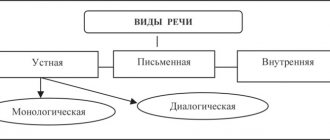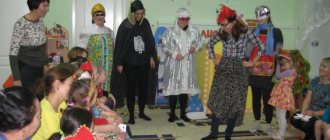Card index of didactic games on the sound culture of speech for the second junior group
Card index of didactic games on the sound culture of speech
for the second younger group
Educator:
Malina A.N.
Didactic game “Guess what it sounds like”
Goal: To introduce children to the sounds of the world around them, to isolate and recognize them. Progress: The teacher shows the objects one by one and demonstrates how they sound. Then the teacher offers to solve riddles. He closes the screen and acts with different objects, and the children recognize which objects the different sounds belong to. Explains that there are many sounds in the world and they all sound differently.
Didactic game "Clock"
Goal: To develop children's speech attention.
Progress: V-l: Listen to how the clock ticks: “Tick-tock, tick-tock”, how the clock strikes: “Bom-bom...”. In order for them to walk, you need to wind them up: “backgammon…”! Let's wind up a big clock (children repeat the corresponding sound combination 3 times); Our clock goes and first ticks, then strikes (sound combinations are repeated by children 5-6 times).
- Now let’s wind up the small clock, the clock goes and sings quietly, the clock strikes very quietly (the children imitate the movement and ringing of the clock with their voices each time).
Didactic game “Bear cubs eat honey”
Goal: To develop the articulatory apparatus of children.
Progress: The teacher tells the children that they will be bear cubs, and bear cubs really love honey. He suggests bringing your palm closer to your mouth (with your fingers) and “licking” the honey - the children stick out their tongues and, without touching their palm, imitate that they are eating honey. Then, raising the tip of the tongue, they remove it (mandatory demonstration of all actions by the teacher.) The game is repeated 3-4 times. Then the teacher says: “The bear cubs are full. They lick the upper lip (show), the lower lip (show). They stroke their bellies, saying: “Ooooh” (2-3 times).
Didactic game “Frog and little frogs”
Goal: To develop children's speech attention.
Progress: The teacher divides the children into two groups: large and small frogs. He says: “Big frogs jump into the pond, swim in the water and croak loudly: “Kva-kva” (children imitate that they are swimming and croak loudly). Little frogs also jump into the pond, swim, and croak quietly (children imitate the actions and croak quietly). All the frogs got tired and sat down on the sand on the shore.” Then the children change roles and the game is repeated.
Didactic game “Let’s feed the chicks”
.
Goal: To develop the speech apparatus of children.
Progress: (I am the mother bird, and you are my little chicks. The chicks are cheerful, they squeak: “pee-pee,” and flap their wings. The mother bird flew for tasty crumbs for her children, and the chicks fly merrily and squeak The mother arrived and began to feed her children (the children squat down, raise their heads up, the chicks open their beaks wide, they want tasty crumbs. (The teacher tries to get the children to open their mouths wider.) The game is repeated 2-3 times.
Didactic exercise “At the doctor’s appointment”
.
Goal: To develop the articulatory apparatus of children.
Progress: The doll is a doctor. She wants to see if the children's teeth hurt. Q: Show the doctor your teeth (the teacher with the doll quickly walks around the children and says that everyone has good teeth. Now the doctor will check if you have a sore throat. Whoever she approaches will open his mouth wide (the children open their mouths wide). Doctor I’m happy: no one’s throat hurts.
Didactic game “Guess what it sounds like”
Goal: Continue to isolate and recognize the sounds of individual musical instruments. Procedure: The teacher shows musical instruments one by one and demonstrates how they sound. Then the teacher offers to solve riddles. He closes the screen and acts with different instruments, and the children recognize what different sounds belong to.
Didactic game “Recognize by voice”
.
Goal: To clarify and reinforce the correct pronunciation of sounds. Progress: The teacher shows the toys and asks who it is, asks to say how it screams. The screen is closed and one subgroup of children takes the toys and takes turns speaking for their animals. Another group guesses who shouted.
Didactic game “Who lives in the house?”
.
Goal: To reinforce the correct pronunciation of sounds. Develop children's speech breathing. Progress: (The teacher shows a picture of a dog). Who is this? The dog barks loudly: “aw-aw.” And who is this? (children's answers) The puppy barks quietly (children repeat the sound combination 3-4 times). (The teacher shows a picture of a cat). Who is this? The cat meows loudly: “Meow-meow.” And who is this? (children's answers) The kitten meows quietly. Let the little animals go home (the pictures are put away behind the cubes). Guess who lives in this house: “av-av” (pronounced loudly? (children’s answers) That’s right, a dog (shows a picture). How did it bark? (children’s answers). Guess who lives in this house: “meow-meow "(pronounces quietly? How did the kitten meow? Similarly, children guess who lives in other houses and repeat sound combinations several times.
Didactic game “Who is screaming? »
Goal: To develop children's speech attention.
Progress: The mother bird had a little chick (puts out pictures). His mother taught him to sing. The bird sang loudly: “chirp - chirp” (children repeat the sound combination). And the chick answered quietly: “chirp-chirp” (children repeat the sound combination 3-4 times). The chick flew and flew far away from its mother (moves the picture of the chick further away). The bird is calling its son. What does she call him? (Children, together with the teacher, repeat the sound combination). The chick heard its mother calling him and chirped. How does he tweet? (Children say quietly). He flew to his mother. The bird sang loudly. How?
Didactic game “Call your mother”
Goal: To reinforce the correct pronunciation of sounds. Develop intonation expressiveness. Progress: All children have object pictures with baby animals. Educator: “Who is your picture, Kolya? (chicken) Who is the chicken's mother? (chicken) Call your mother, chicken. (Peep-pee-pee) The teacher imitates the clucking of a chicken and shows a picture.
The same work is carried out with all children.
Didactic game “Respond”.
Goal: To reinforce the correct pronunciation of sounds. Develop intonation expressiveness. Progress: Educator: This is a goat (showing a picture). How is she screaming? Who is her cub? How does he scream? This is a sheep (show picture). How does she bleat? And how does her baby lamb scream? etc. Pictures are displayed on flannelgraph. The teacher hands out pictures of animals and birds to the children. The cubs are walking (the children leave the tables, they are nibbling the grass, the crumbs are pinching. Whose mother or whose father will call the cub. He must shout - answer them - and run - put a picture next to them. The teacher pronounces the cry of an animal or bird. The child, which the cub is depicted makes sounds and places the picture on the flannelgraph.
Game "Guess what to do"
.
Target. Teach children to correlate the nature of their actions with the sound of the tambourine. Developing children's ability to switch auditory attention. Preparatory work. Prepare 2 flags for each child. Progress: Children sit in a semicircle. Each person has 2 flags in their hands. If the teacher rings the tambourine loudly, the children raise the flags up and wave them; if quietly, they keep their hands on their knees.
Methodical instructions. An adult needs to monitor the correct posture of children and the correct execution of movements; It is necessary to alternate the loud and quiet sound of the tambourine no more than four times so that children can easily perform the movements.
Game "Sun or Rain?"
Target. Teach children to perform actions according to the different sounds of the tambourine. Developing children's ability to switch auditory attention. Progress: The adult says to the children: “Now you and I will go for a walk. We go for a walk. There is no rain. The weather is good, the sun is shining, and you can pick flowers. You walk, and I will ring the tambourine, you will have fun walking to the sound of it. If it starts to rain, I will start knocking on the tambourine, and when you hear the knock, you must run into the house. Listen carefully when the tambourine rings and when I knock on it.” Methodical instructions. The teacher plays the game, changing the sound of the tambourine 3 - 4 times.
Game "Where did they call?"
.
Target. Teach children to determine the direction of sound. Development of the direction of auditory attention.
Preparatory work. An adult prepares a bell.
Progress: Children sit in a circle. The adult chooses a driver who stands in the center of the circle. At the signal, the driver closes his eyes. Then the teacher gives one of the children a bell and invites them to call. The driver, without opening his eyes, must indicate with his hand the direction from which the sound is coming. If he points correctly, the adult says: “It’s time,” and the driver opens his eyes, and the one who called raises and shows the bell. If the driver makes a mistake, he guesses again, then another driver is appointed. Methodical instructions. The game is repeated 4-5 times. You need to make sure that the driver does not open his eyes during the game. Indicating the direction of the sound, the driver turns to face the place from which the sound is heard. The call should not be very loud.
Game "Butterfly, fly!"
.
Target. Achieve long, continuous oral exhalation. Preparatory work. Prepare 5 brightly colored paper butterflies. Tie a thread 50 cm long to each and attach them to the cord at a distance of 35 cm from each other. Pull the cord between two posts so that the butterflies hang at the level of the standing child’s face.
Progress: Children sit on chairs. The adult says: “Children, look how beautiful the butterflies are: blue, yellow, red! There are so many of them! They look like they're alive! Let's see if they can fly. (Blows on them.) Look, they flew. Try to blow too. Who will fly further? The adult invites the children to stand one by one next to each butterfly. Children blow on butterflies. Methodical instructions. The game is repeated several times, each time with a new group of children. It is necessary to ensure that children stand straight and do not raise their shoulders when inhaling. You should only blow on one exhalation, without drawing in air. Do not puff out your cheeks, move your lips slightly forward. Each child can blow for no more than ten seconds with pauses, otherwise he may become dizzy.
Game "Sending the Boats"
.
Target. Achieve from each child the ability to pronounce the sound f for a long time on one exhalation or repeatedly pronounce the sound p (p-p-p) on one exhalation. Developing the ability to combine the pronunciation of a sound with the beginning of exhalation. Preparatory work. An adult prepares a bowl of water and paper boats. Procedure: Children sit in a large semicircle. There is a bowl of water on a small table in the center. The summoned children, sitting on chairs, blow on the boats, pronouncing the sound f or p. The teacher invites the children to ride on a boat from one city to another, marking the cities with icons on the edges of the pelvis. In order for the boat to move, you need to blow on it slowly, with your lips pressed together, as if you were pronouncing the sound f. You can blow by simply stretching your lips with a tube, but without puffing out your cheeks. The ship moves smoothly. But then a gusty wind comes. “P-p-p...” the child blows. (When repeating the game, you need to drive the boat to a certain place). Methodical instructions. Make sure that when pronouncing the sound f, children do not puff out their cheeks; so that children pronounce the sound p on one exhalation 2-3 times and do not puff out their cheeks.
Game "Loud - Quiet"
.
Target. Teach children to change the strength of their voice: speak loudly, then quietly. Developing the ability to change the strength of your voice.
Preparatory work. The teacher selects paired toys of different sizes: large and small cars, large and small drums, large and small pipes.
Progress: An adult shows 2 cars and says: “When a big car drives, it makes a loud signal: “beep.” How does a big car signal? Children say loudly: “Bee-Bee.” The teacher continues: “And the small car beeps quietly: “beep.” How does a small car honk? Children quietly say: “Bee-Bee.” The teacher removes both cars and says: “Now be careful. As soon as the car starts moving, you must give a horn, make no mistake, a big car honks loudly, and a small car honks quietly.” The rest of the toys are played in the same way. Methodical instructions. Depending on the number of children in the group, you can use one pair of toys or 2-3. Make sure that when pronouncing onomatopoeia quietly, children do not whisper.
Didactic game "Shop".
Goal: To reinforce the correct pronunciation of sounds. Develop intonation expressiveness. Progress: The teacher suggests going to the store and buying toys. You can only buy it if you talk like a toy. Children come up to the table and pronounce characteristic sound combinations for this toy (doo-doo, me-me, bi-bi)
Didactic game “Be attentive.”
Goal: To reinforce the correct pronunciation of sounds. Develop intonation expressiveness. Progress: Educator: I have different pictures, if I show a picture of an animal, you must scream as it screams and raise the blue circle. If I show you a toy, you raise the red circle and name the toy.
Didactic game "Bells"
.
Goal: To develop children's speech attention. Progress: Q: Look, this is a big bell, and this is a small bell. The girls will be little bells. They ring: “Ding-ding-ding.” Boys will be big bells. They ring: “Ding-ding-dinging.” The teacher offers to “ring” and sing songs first to the girls, then to the boys. The exercise is repeated 2 times, then the children change roles and the game is repeated.
Didactic game “Animals are coming”
.
Goal: To develop children's speech attention.
Progress: The teacher divides the children into four groups - elephants, bears, piglets and hedgehogs. Educator: Elephants are walking, they stomp their feet very loudly (children pronounce the sound combination “top-top-top” loudly, repeat it 3-4 times. - Bears are coming, they stomp more quietly (children repeat the sound combination 3-4 times a little more quietly). - The piglets are walking, they stomp even quieter... -The hedgehogs are walking, they stomp very quietly... -The elephants are walking (children walk in the group, stomp and pronounce the sound combination loudly). The same work is done with other animals. Then the children change roles according to their choice, and the game is repeated.
Didactic game “Cuckoo and the pipe”
.
Goal: To develop children’s phonemic hearing and speech attention. Progress: Q: A bird lives in the forest - a cuckoo (show picture). She crows: “Ku-ku, kuk-ku” (children repeat the sound combination 3-4 times). One day the children came to the forest to pick mushrooms. We picked a lot of mushrooms. We got tired, sat down in a clearing to rest and played the pipes: “Doo-doo-doo” (children repeat the sound combination 3-4 times). The teacher divides the children into two groups - cuckoos and pipes. Without a system, he gives different commands 6-7 times (sometimes to cuckoos, sometimes to pipes). Then the children change roles and the game is repeated.
Didactic game “Hit a nail with a hammer.”
Goal: To develop children’s phonemic hearing and speech attention. Progress: B: When the big hammer knocks, you can hear: “Knock-knock-knock” (children repeat the sound combination 5-6 times). When a small hammer knocks, you can hear: “Bale-buck-buck” (children repeat the sound combination 5-6 times). Let's hammer a nail with a large hammer... Now let's hammer a small nail with a small hammer... Close your eyes and listen to which hammer is knocking (without a system, the teacher repeats sound combinations 4-5 times, and the children say which hammer is knocking).
Didactic exercise “Let’s blow on a ball”
.
Goal: To develop the articulatory apparatus of children.
Procedure: Children take the ball by the string, hold it in front of their mouth and say: “Pf-f-f” (blow on the ball). The exercise is repeated 3 times, then the children rest and repeat the exercise 3 more times.
Didactic exercise “Breeze”.
Goal: To develop the articulatory apparatus of children.
Procedure: Children take a leaf by a thread, hold it in front of their mouth and say: “Pf-f-f” (blow on an autumn leaf). The exercise is repeated 3 times, then the children rest and repeat the exercise 3 more times.
Didactic exercise “Let’s lick our lips.”
Goal: To develop the articulatory apparatus of children.
Move: Teacher: Let's eat candy (children and teacher imitate eating candy and smack their lips). The candies are delicious, let’s lick our lips (demonstration: run your tongue along the upper lip from edge to edge, then along the lower lip - you should get circular movements).
Didactic game "Geese".
Purpose: to clarify and consolidate the pronunciation of the sound a, to prepare children for composing text descriptions.
Material: painting "Geese"
Procedure: The teacher shows the children a picture, they look at it together. These are geese. Geese are white and gray. The goose has a long neck and red feet. The goose shouts: ha-ha-ha. What kind of neck does a goose have? What paws? How does a goose scream? (Children's answers.) Now we will be geese. We walk, shift from foot to foot. (The teacher shows how geese walk. The children repeat the movements after him.) Cackle: ha-ha-ha. B: Geese, geese! Children: Ga-ga-ga Q: Do you want to eat? Children: Yes, yes, yes Q: Show how geese open their beaks wide. Children: Ga-ga-ga. Q: Do you want to eat? Children: Yes, yes, yes. The geese flapped their wings and flew away. (The game is repeated 3-4 times)
Didactic game “Guess by Voice”
Goal: to clarify and consolidate the correct pronunciation of sounds in isolation and in words; learn to form verbs from onomatopoeic words. Material: basket with toys. Progress: Q: Who came to us? (This (takes out a cockerel, a frog, a duck)… D: Rooster B: And this, children (shows a picture), is a cuckoo. How does a cuckoo crow? Cuckoo, cuckoo! Whose voice is this? Who quacks like that?: quack -quack7 Children: Duck. Q: Who croaks croak?... Q: Who crows: crowing?... Q: How does the cuckoo crow? Q: Now we'll play with you. Here's a cockerel (shows a toy cockerel). How does he sing? ? When the cockerel sings “Cuckoo!”, what does he do? (crows) Q: And this is a cuckoo (shows a picture). How does she voice? (cuckoo) D: When the cuckoo says cuckoo, what does she do? cuckoo ) Q: Show how the cuckoo flies. (Children rise from the carpet and fly.) How does a cuckoo crow? (children crow.) Show how the cockerel flaps its wings. (children show.) How does he shout to the crow? (Children crow) What were you doing just now, like a cockerel? (crowed.) Listen to the words: cuckoo, rooster, duck, frog. The sound u is heard in these words. pull it: oooh. Name words with the sound y: cuckoo, rooster, frog, uuuck. (Says with the children) The toys are left for children to play freely.
Didactic game “Teach the bunny to speak correctly”
Goal: To develop intonation expressiveness.
Q: The bunny brought a wonderful bag with him. It contains different pictures. The bunny will talk. What is written on them? If he says it wrong, you will teach him to say it correctly. Ishka – children correct “bear” Herringbone – squirrel Onik – elephant (After “training” the bunny begins to name all the objects correctly.
Didactic game "Riddles".
Q: Our frog loves to solve riddles. The teacher uses gestures, facial expressions, and sounds to depict the animal, and the children guess the riddle. The teacher offers to read a poem about the guessed animal. (The owner abandoned the bunny... The bear is clumsy...) Next, the children ask riddles.






